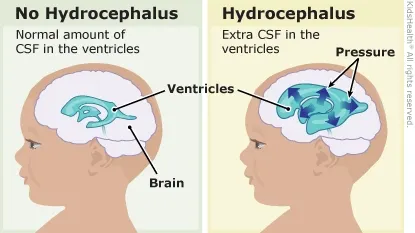What is Hydrocephalus?
Hydrocephalus is a condition characterized by an abnormal accumulation of cerebrospinal fluid (CSF) in the brain. This excess fluid leads to increased pressure inside the skull, which can cause brain damage and a range of neurological symptoms. The condition can occur at any age but is most commonly seen in infants and older adults.
Cerebrospinal fluid (CSF) is responsible for cushioning the brain and spinal cord, providing essential nutrients, and removing waste products. Under normal circumstances, the body maintains a balance between the production and absorption of CSF. However, in hydrocephalus, this balance is disrupted due to overproduction, inadequate absorption, or a blockage that prevents normal fluid flow.

Causes of Hydrocephalus
Hydrocephalus can be classified into different types based on its cause:
- Congenital Hydrocephalus
This form is present at birth and may result from genetic disorders or developmental abnormalities in the fetal brain.
Common causes include neural tube defects (such as spina bifida) and infections during pregnancy like rubella or toxoplasmosis. - Acquired Hydrocephalus
This develops later in life due to infections, injuries, or diseases.
Causes include meningitis, brain tumors, head trauma, or complications from brain hemorrhages. - Communicating Hydrocephalus
Occurs when CSF flow is not blocked, but there is an issue with its absorption into the bloodstream.
This can be due to infections, inflammation, or bleeding in the brain. - Non-Communicating (Obstructive) Hydrocephalus
Happens when a physical blockage prevents CSF from circulating properly.
Common causes include brain tumors, cysts, or structural abnormalities. - Normal Pressure Hydrocephalus (NPH)
Primarily affects older adults and leads to a gradual buildup of CSF, causing walking difficulties, urinary incontinence, and cognitive decline.
Often mistaken for Parkinson’s disease or Alzheimer’s.
Symptoms of Hydrocephalus
The symptoms vary depending on the patient’s age and the severity of the condition.
In Infants
- Unusually large head size
- Bulging soft spot (fontanelle) on the head
- Vomiting and poor feeding
- Irritability and excessive sleepiness
- Seizures
- Downward deviation of the eyes (sun-setting eyes)
In Older Children and Adults
- Headache (often worse in the morning)
- Nausea and vomiting
- Blurred or double vision
- Balance and coordination problems
- Memory and concentration difficulties
- Personality or behavioral changes
- In Elderly Individuals (Normal Pressure Hydrocephalus – NPH)
- Difficulty walking (shuffling gait)
- Urinary incontinence
- Memory loss and confusion

Diagnosis of Hydrocephalus
Hydrocephalus is diagnosed using a combination of clinical evaluation and imaging studies.
- Neurological Examination
A doctor assesses the patient’s balance, coordination, reflexes, muscle strength, and cognitive function. - Imaging Tests
Ultrasound: Used for diagnosing hydrocephalus in infants.
CT Scan: Provides a detailed view of brain structures and detects enlarged ventricles.
MRI Scan: Helps identify blockages and other abnormalities in the brain. - Lumbar Puncture (Spinal Tap)
In some cases, a small amount of CSF is removed to check pressure levels and determine if fluid drainage improves symptoms. - Intracranial Pressure Monitoring
A special device is placed inside the skull to measure pressure changes.
Treatment Options for Hydrocephalus
The treatment for hydrocephalus depends on its severity and underlying cause. Most cases require surgical intervention.
- Medications (For Temporary Relief)
In some cases, medications can reduce CSF production and alleviate symptoms temporarily.
However, they are not a long-term solution. - Shunt Placement Surgery (Most Common Treatment)
A ventriculoperitoneal (VP) shunt is surgically placed to redirect excess CSF from the brain to another part of the body (usually the abdomen), where it can be absorbed. - Types of Shunts:
- Ventriculoperitoneal (VP) Shunt: Drains fluid to the abdominal cavity.
- Ventriculoatrial (VA) Shunt: Directs fluid into the heart.
- Lumboperitoneal Shunt: Redirects CSF from the lower spine to the abdomen.
- Shunt systems require lifelong monitoring as they may get blocked or infected.
4. Endoscopic Third Ventriculostomy (ETV)
In some cases, an alternative to shunt surgery is ETV.
A small hole is made in the third ventricle of the brain to allow CSF to bypass blockages and flow normally. This procedure is effective for some patients with obstructive hydrocephalus.
5. Treatment for Normal Pressure Hydrocephalus (NPH)
A lumbar drain trial may be used to see if removing CSF improves symptoms. If beneficial, a VP shunt is implanted to provide long-term relief.

Complications of Hydrocephalus
If left untreated, hydrocephalus can lead to severe complications, including:
- Permanent brain damage
- Vision loss
- Seizures
- Developmental delays in children
- Difficulty walking or loss of mobility
Prognosis and Long-Term Management
With early diagnosis and proper treatment, many people with hydrocephalus can lead a normal life. However, lifelong monitoring is necessary to prevent complications.
- Regular Medical Follow-Ups
Patients with shunts require periodic check-ups to ensure they are functioning properly.
Imaging scans may be done to monitor brain pressure levels. - Physical Therapy
Helps improve balance, coordination, and mobility in affected individuals. - Cognitive Therapy
Beneficial for patients with memory or concentration difficulties. - Special Care for Children
Children with hydrocephalus may need speech and occupational therapy to support their development.
What is hydrocephalus and what causes it?
Hydrocephalus, often referred to as “water on the brain,” is a condition characterized by an accumulation of cerebrospinal fluid (CSF) within the brain’s ventricles. This buildup increases intracranial pressure, potentially leading to brain tissue damage. Causes of hydrocephalus include congenital factors like spina bifida, infections such as meningitis, brain tumors, traumatic brain injuries, and complications from premature birth. In older adults, normal pressure hydrocephalus (NPH) can develop, sometimes without a clear cause .
What are the symptoms of hydrocephalus in adults and children?
Symptoms of hydrocephalus vary by age. In infants, signs include an unusually large head, bulging soft spots, vomiting, and irritability. Children may experience headaches, blurred vision, balance issues, and developmental delays. Adults often report headaches, difficulty walking, urinary incontinence, and cognitive challenges. In older adults, NPH symptoms can mimic dementia, presenting as memory loss, gait disturbances, and bladder control problems .
How is hydrocephalus diagnosed?
Diagnosing hydrocephalus involves a combination of medical history evaluation, neurological examinations, and imaging tests. MRI and CT scans are commonly used to detect enlarged ventricles and assess CSF accumulation. In cases of NPH, additional tests like lumbar punctures or infusion studies may be conducted to evaluate CSF pressure and absorption .
What treatment options are available for hydrocephalus?
The primary treatment for hydrocephalus is surgical intervention. A common procedure is the insertion of a ventriculoperitoneal (VP) shunt, which diverts excess CSF from the brain to the abdominal cavity. Another option is endoscopic third ventriculostomy (ETV), where a small hole is made in the floor of the third ventricle to allow CSF to bypass obstructions and flow toward absorption sites .
Can hydrocephalus be cured or managed long-term?
While hydrocephalus is a chronic condition, many individuals manage it effectively with appropriate treatment. Shunt systems often require regular monitoring and occasional revisions. With timely intervention and ongoing care, patients can lead active lives, though some may experience long-term effects depending on the severity and duration before treatment .
What is the recovery time after hydrocephalus surgery?
Recovery time varies based on the surgical procedure and individual patient factors. Patients undergoing VP shunt placement may stay in the hospital for a few days, with full recovery spanning several weeks. Those undergoing ETV might experience shorter hospital stays and quicker recoveries. Postoperative care includes monitoring for complications and ensuring the proper function of the shunt or ETV




